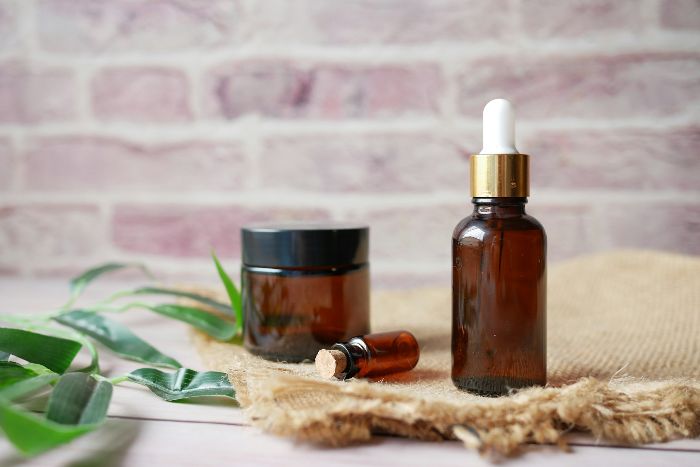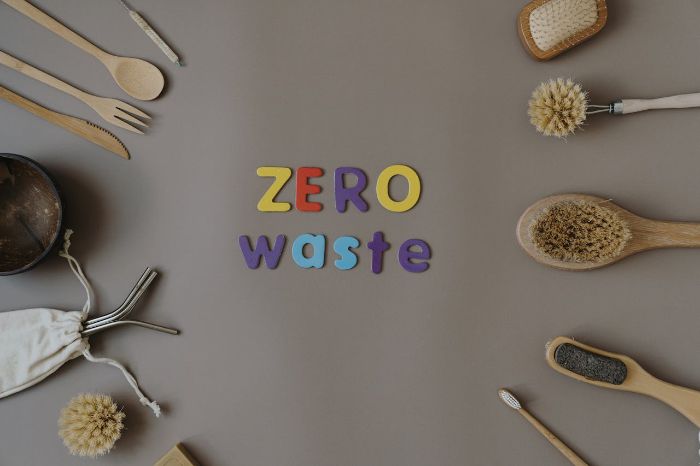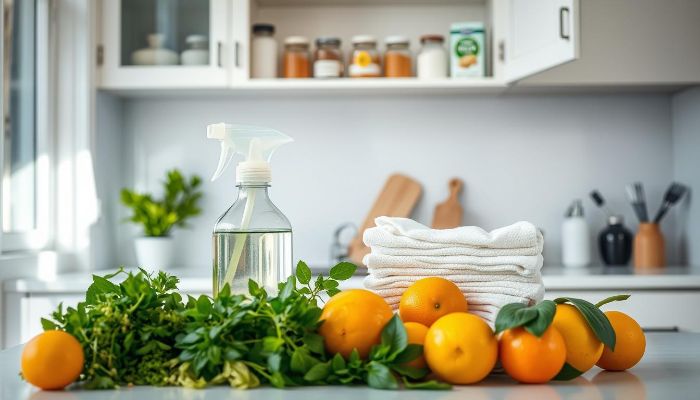Updated October 17, 2025
Conventional cleaning products often leave behind more than a shine – they introduce synthetic residues, allergens, and airborne toxins into the home. Essential oils offer a clean break. With natural antimicrobial properties and pleasant botanical aromas, they replace harsh chemicals with safer, high-performance alternatives. When used correctly, essential oils deliver effective, science-backed cleaning power across every room – without compromising your health or the environment.
Key Takeaways
- Essential oils offer a chemical-free way to disinfect and clean household surfaces.
- Natural cleaning reduces indoor toxins and improves air quality.
- Specific oils like tea tree, lemon, and eucalyptus target germs effectively.
- DIY recipes with essential oils are cost-efficient and environmentally safe.
- Safe dilution and application protect both surfaces and household members.
- Proper blending and storage maximize the cleaning power and longevity of oils.
Table of Contents
Why Essential Oils Belong in Modern Home Cleaning
Switching to essential oils isn’t just about avoiding chemicals – it’s a move toward smarter, safer, and more effective cleaning. These concentrated plant extracts deliver antimicrobial action, fresh aroma, and peace of mind, making them ideal for every surface and space.
How Essential Oils Neutralize Germs Naturally
Essential oils like tea tree, eucalyptus, and lemon are scientifically proven to inhibit bacteria, fungi, and viruses. Unlike synthetic disinfectants that rely on harsh chemicals, these oils penetrate cell membranes and disrupt pathogens on a molecular level. This makes them effective on countertops, sinks, and high-touch areas – without toxic residue.
Why Natural Scents Are Better Than Synthetic Fragrances
Most commercial cleaners rely on artificial fragrances that can trigger allergies, respiratory issues, or skin irritation. Essential oils offer complex natural scents that not only deodorize but also support mental well-being. Lavender and citrus oils, for example, refresh the air while promoting calm or energy – turning routine cleaning into a more pleasant, holistic experience.
High-Impact Essential Oils for Cleaning and Disinfection
Not all essential oils are created equal when it comes to household cleaning. The most effective options combine germ-killing power with aromatic benefits, offering a dual function – sanitizing surfaces while refreshing your space.
Tea Tree, Lemon, and Eucalyptus – Targeting Germs at the Source
- Tea Tree Oil – Broad-spectrum antifungal and antibacterial properties. Ideal for disinfecting humid spaces like bathrooms and for use in mold-prone areas.
- Lemon Oil – Powerful natural degreaser with antimicrobial action. Effective on kitchen countertops, stovetops, and cutting boards.
- Eucalyptus Oil – Known for eliminating airborne microbes and refreshing stale indoor air. Excellent for living areas and multi-surface sprays.
Lavender, Peppermint, and Orange – For Cleanliness and Sensory Appeal
- Lavender Oil – Offers antimicrobial protection with calming aromatic benefits. Best used in bedroom linen sprays and relaxation areas.
- Peppermint Oil – Sharp, invigorating scent with mild disinfectant properties. Deters insects and works well in entryways or windowsills.
- Sweet Orange Oil – Naturally uplifting and effective at breaking down sticky residues. Useful in surface cleaners for high-touch areas like tables and handles.
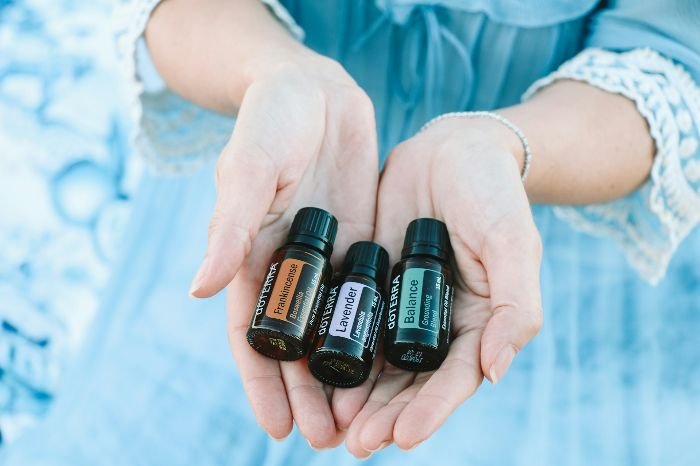
DIY Cleaning Recipes with Essential Oils – Effective, Customizable Solutions
Homemade cleaning products allow full control over ingredients, safety, and scent – without sacrificing cleaning performance. The following essential oil recipes are simple to prepare, cost-efficient, and effective for day-to-day use across your home.
Multi-Surface Spray – Lemon and Tea Tree Oil
Best for: countertops, sinks, tiles, door handles
Ingredients:
- ½ cup white vinegar
- 1½ cups warm water
- 15 drops tea tree essential oil
- 15 drops lemon essential oil
Instructions:
Combine ingredients in a spray bottle and shake well. Spray directly onto surfaces, then wipe clean with a microfiber cloth. Shake before each use for best results.
Bathroom Scrub – Peppermint and Baking Soda
Best for: toilets, tubs, tile grout, bathroom sinks
Ingredients:
- ¾ cup baking soda
- ¼ cup liquid castile soap
- 1 tablespoon water
- 10 drops peppermint essential oil
Instructions:
Mix into a thick paste. Apply to surfaces using a sponge or brush. Let sit for 3–5 minutes, then scrub and rinse thoroughly. Avoid using on natural stone or delicate finishes.
Optional Boost – Add Lavender for Balance
Add 5 drops of lavender essential oil to either recipe for additional antimicrobial benefits and a calming scent profile.
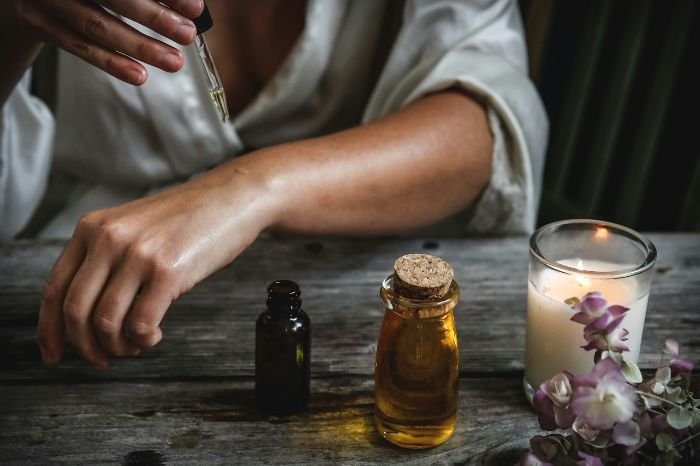
Safe Usage and Dilution Guidelines – Avoid Irritation and Maximize Effectiveness
Essential oils are powerful natural compounds – using them correctly ensures they clean effectively without risking surface damage, skin irritation, or harm to pets and children. The key lies in proper dilution and informed application.
Recommended Dilution Ratios for Cleaning Solutions
- General surface cleaning – 10–20 drops of essential oil per 1 cup (240 ml) of carrier (e.g., water, vinegar, or alcohol).
- High-strength disinfecting – up to 30 drops per cup for heavily soiled or high-touch areas.
- Glass and mirror sprays – keep to 5–10 drops per cup to avoid streaking.
Always mix well before use, and store in opaque spray bottles to preserve oil potency.
Safety Tips for Homes with Kids and Pets
Keep essential oils out of reach – ingestion or skin exposure can be dangerous, especially for toddlers and pets.
Avoid citrus oils around dogs and cats – limonene and linalool compounds can be toxic to animals even in small amounts.
Do a surface test first – apply diluted oil to a hidden corner to check for discoloration or damage, especially on wood, stone, or varnished surfaces.
Ventilate enclosed areas – concentrated vapors can cause headaches or respiratory irritation.
Used responsibly, essential oils offer a safe and sustainable alternative to synthetic chemicals. Understanding dilution and surface compatibility turns natural cleaning into a practical, risk-free solution.
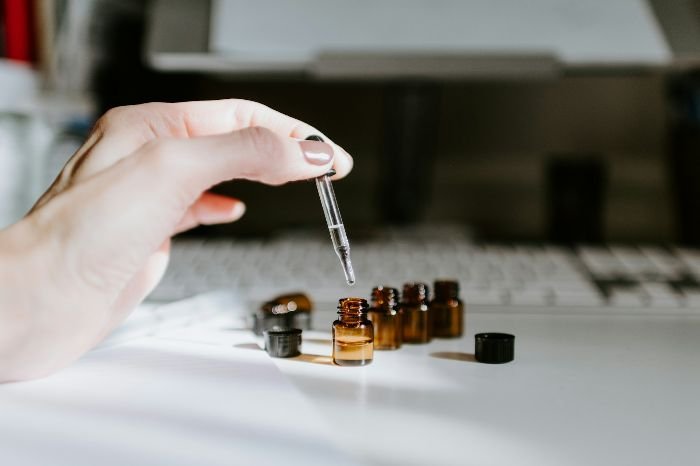
Tailoring Essential Oils to Specific Rooms and Cleaning Needs
Not all rooms require the same approach when it comes to cleaning with essential oils. Kitchens demand degreasing and odor control, while bedrooms benefit from calming, allergen-reducing blends. Choosing the right oil for the right space amplifies both effectiveness and atmosphere.
Kitchen – Degreasing Sprays and Surface Refreshers
The kitchen is a hotspot for grease, food residue, and persistent smells. Essential oils like lemon, grapefruit, and tea tree excel in these high-use areas due to their degreasing and antimicrobial properties. A simple surface spray made from citrus oil, white vinegar, and distilled water breaks down grease while neutralizing odors. When used in wipe form, these blends keep counters fresh without synthetic chemicals.
Beyond functionality, citrus oils leave behind a clean, uplifting scent that pairs naturally with cooking spaces.
Bedroom – Linen Mists and Allergen Reduction
Bedrooms benefit from oils that promote relaxation and purify air without overwhelming the senses. Lavender and chamomile are ideal for linen sprays – lightly misted on pillows and bedding, they support restful sleep and subtly freshen textiles.
Dusting blends with eucalyptus or cedarwood add antimicrobial action while helping to repel dust mites. Used properly, these oils reduce allergens and transform bedroom upkeep into a sensory experience aligned with comfort and calm.
When matched to room function, essential oils do more than clean – they refine the character of a space.
Blending and Storing Essential Oils for Maximum Effectiveness
The power of essential oils lies not just in their individual properties, but in how they’re combined and preserved. Mastering the basics of oil blending and proper storage ensures lasting potency, consistent scent, and optimal cleaning performance across all uses.
How to Blend Oils for Balanced Cleaning Performance and Aroma
Combining the right oils amplifies both their antibacterial action and aromatic appeal. Start with blends that complement each other chemically and olfactively:
- Tea tree + Lemon – boosts antimicrobial power with a clean citrus scent.
- Eucalyptus + Lavender – merges respiratory support with calming freshness.
- Peppermint + Orange – invigorates spaces while tackling surface grime.
Use 2–3 oils per blend and begin with small test batches to evaluate scent strength and performance. Keep ratios balanced – overpowering one oil can distort both function and fragrance.
Storage Tips to Extend Shelf Life and Maintain Potency
Improper storage degrades essential oils quickly. To retain their potency:
- Store oils in dark glass bottles (preferably amber or cobalt) to shield from UV light.
- Keep them in a cool, dry place – away from heat sources, humidity, or direct sun.
- Ensure airtight seals on all containers to prevent oxidation and evaporation.
- Label bottles with purchase or open date, and aim to use most oils within 1–2 years.
Well-stored oils deliver consistent results in every cleaning task, while poor storage leads to weakened aroma and reduced microbial action.
Common Mistakes When Cleaning with Essential Oils – And How to Avoid Them
While essential oils are powerful cleaning allies, improper use can reduce their effectiveness or even damage surfaces. Understanding the most frequent missteps helps ensure a safe, efficient, and results‑driven natural cleaning routine.
Using Undiluted Oils on Delicate Surfaces
Essential oils are highly concentrated and must always be diluted before use. Applying them directly can cause:
- Surface damage (especially to plastics, wood finishes, and stone)
- Skin irritation or allergic reactions
- Residue buildup or staining
Solution: Always follow recommended dilution ratios – typically 10–30 drops per cup of carrier solution (water, vinegar, or alcohol). Test first on a hidden spot.
Overreliance on Scent Instead of Cleaning Efficacy
A pleasant scent doesn’t equal a clean surface. Some users focus more on fragrance than actual cleaning results, leading to:
- Incomplete grime or residue removal
- False sense of cleanliness
- Excessive oil use without purpose
Solution: Use essential oils as functional ingredients – not just deodorizers. Combine them with proven cleaning agents like vinegar, baking soda, or castile soap.
Ignoring Surface Compatibility and Material Sensitivity
Certain surfaces, like natural stone, untreated wood, or high-gloss finishes, can react poorly to acidic or oily solutions.
Solution: Match oils and carriers to appropriate materials. Avoid citrus oils on marble or granite, and steer clear of excessive moisture on wood. When in doubt, use a small test patch.
Final Thoughts – Redefining Clean with Nature’s Tools
Switching to essential oils for home cleaning is more than a trend – it’s a practical shift toward safer living and environmental responsibility. These plant-based extracts offer real antimicrobial power without exposing your home to synthetic chemicals. With proper dilution, smart blending, and surface-specific use, essential oils can match or outperform many commercial products.
Whether you’re tackling grime, refreshing linens, or simply aiming for a healthier space, essential oils bring both effectiveness and atmosphere. By integrating them into your cleaning habits, you’re not just maintaining a tidy home – you’re creating a space that supports wellbeing, sustainability, and long-term peace of mind.
FAQ
What makes essential oils effective for cleaning?
Essential oils contain naturally occurring compounds with antimicrobial, antifungal, and antiviral activity. They disrupt microbial cell membranes and inhibit pathogen growth, making them powerful tools for household disinfection.
Which essential oils are most effective against germs?
Tea tree, eucalyptus, lemon, thyme, and clove oils are among the most effective. Each has been studied for its ability to combat bacteria, fungi, and viruses on hard surfaces.
Are essential oils safe for homes with pets and children?
With proper dilution and careful oil selection, essential oils can be used safely. However, some, like citrus and tea tree, may be harmful to pets if misused. Always consult veterinary guidance before use around animals, and keep oils out of reach of children.
Can essential oils replace all commercial cleaning products?
Essential oils can replace many household cleaners, especially for daily use. However, for heavy-duty disinfection (e.g., medical-grade sanitization), they should complement, not replace, certified products.
What’s the correct dilution ratio for cleaning solutions?
A general guideline is 10–30 drops of essential oil per 1 cup of carrier liquid (such as vinegar or water). Always test mixtures on inconspicuous surfaces before widespread use.
How should essential oils be stored to maintain effectiveness?
Store oils in dark glass bottles, away from heat and sunlight. Keep them tightly sealed and in a cool location. Proper storage preserves aroma, chemical stability, and cleaning efficacy.
What are the most common mistakes when cleaning with essential oils?
Overuse and poor dilution are the biggest risks – both can lead to surface damage or health irritation. Another common mistake is using oils only for their scent, overlooking their actual cleaning potential.






